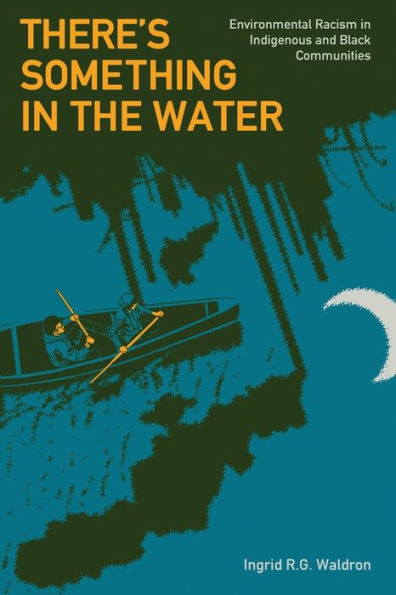
There's Something In The Water: Environmental Racism in Indigenous & Black Communities
184
There's Something In The Water: Environmental Racism in Indigenous & Black Communities
184Paperback
-
PICK UP IN STORECheck Availability at Nearby Stores
Available within 2 business hours
Related collections and offers
Overview
Using settler colonialism as the overarching theory, Waldron unpacks how environmental racism operates as a mechanism of erasure enabled by the intersecting dynamics of white supremacy, power, state-sanctioned racial violence, neoliberalism and racial capitalism in white settler societies. By and large, the environmental justice narrative in Nova Scotia fails to make race explicit, obscuring it within discussions on class, and this type of strategic inadvertence mutes the specificity of Mi’kmaq and African Nova Scotian experiences with racism and environmental hazards in Nova Scotia. By redefining the parameters of critique around the environmental justice narrative and movement in Nova Scotia and Canada, Waldron opens a space for a more critical dialogue on how environmental racism manifests itself within this intersectional context.
Waldron also illustrates the ways in which the effects of environmental racism are compounded by other forms of oppression to further dehumanize and harm communities already dealing with pre-existing vulnerabilities, such as long-standing social and economic inequality. Finally, Waldron documents the long history of struggle, resistance, and mobilizing in Indigenous and Black communities to address environmental racism.

Product Details
| ISBN-13: | 9781773630571 |
|---|---|
| Publisher: | Fernwood Publishing |
| Publication date: | 04/02/2018 |
| Pages: | 184 |
| Sales rank: | 455,731 |
| Product dimensions: | 5.80(w) x 8.90(h) x 0.40(d) |
About the Author
Table of Contents
Acknowledgements ix
Preface
A Rising Tide Lifts All Boats?: Strategic Inadvertence and Other Shortcomings of the Environmental Justice Lens in Nova Scotia 1
Building on the Four Pillars of the Critical Environmental Justice
Studies Framework 7
Setting the Stage 12
Chapter Overview 17
1 Environmental Noxiousness, Racial Inequities, and Community Health Project: Blurring the Boundaries between Community and the Ivory Tower 21
"In Whose Backyard? Exploring Toxic Legacies in Mi'kmaw and African Nova Scotian Communities": Regional Meetings and Final Convergence Workshop 25
The Case of Pictou Landing First Nation 27
The Environmental Racism Prevention Act 29
2015: A Banner Year 31
The Way Forward: Connecting Science with Community Knowledge and the Law 33
2 A History of Violence: Indigenous and Black Conquest, Dispossession, and Genocide in Settler-Colonial Nations 37
Racial Capitalism: Addressing Environmental Racisms Profit Motive 44
Epistemologies of Ignorance 49
3 Rethinking Waste: Mapping Racial Geographies of Violence on the Colonial Landscape 53
In Your Place: Spatialities of Containment and Exclusion in Indigenous and Black Communities 56
Spatial Violence and Genocidal "Slow Death" 58
4 Not in My Backyard: The Politics of Race, Place, and Waste in Nova Scotia 66
Procedural and Distributive Justice 68
Environmental Racism in Indigenous Communities 71
Sydney 74
Pictou Landing First Nation 75
Sipekne'katik Band of the Mi'kmaw First Nation 76
Eskasoni First Nation, Millbrook First Nation, and Acadia First Nation 78
Indigenous Communities in Other Provinces 78
Elsipogtog First Nation 78
First Nations in British Columbia 80
Kashechewan First Nation 81
Athabasca Chipewyan First Nation, Mikisew Cree First Nation, and the Metis Nation 81
Aamjiwnaang First Nation 82
Asubpeeschoseewagong Netum Anishinabek/Grassy Narrows First Nation 83
Environmental Racism in African Nova Scotian Communities 84
Africville 84
Lincolnville 85
The Prestons 87
Shelburne, Cherry Brook, Lake Loon, Truro, and Lucasville 87
5 Sacrificial Lives: How Environmental Racism Gets Under the Skin 89
Environmental Violence: Framing the Complex Web of Inequalities 92
Environmental Health Inequities 100
Psychological stress 103
Cancer 104
Child and Maternal Health 106
6 Narratives of Resistance, Mobilizing, and Activism: The Fight against Environmental Racism in Nova Scotia 108
Mi'kmaw and African Nova Scotian Communities on the Fronthnes 112
Idle No More 112
Pictou Landing First Nation: Boat Harbour 113
Sipekne'katik First Nation and Millbrook First Nation: Alton Natural Gas Storage Project 114
Indigenous Communities across Canada: Energy East Pipeline 116
Africville Genealogy Society: Africville 116
Lincolnville Reserve Land Voice Council: The Second-generation Landfill 118
The Prestons and East Lake: The East Lake Landfill 120
Lucasville Community Association: Memento Farm 122
Truro: Flooding and the Dump 124
South End Environmental Injustice Society: The Morvan Road Landfill 125
Conclusion: The Road Up Ahead 128
A Multi-Pronged Strategy for Addressing Environmental Racism 131
Centring Race in an Environmental Justice Framework 132
Environmental Policy: Addressing Structural and Environmental Determinants of Health 133
Building Coalitions and Solidarities for Environmental Justice Organizing 136
FinalWords 139
Appendices 141
References 144
Index 163
